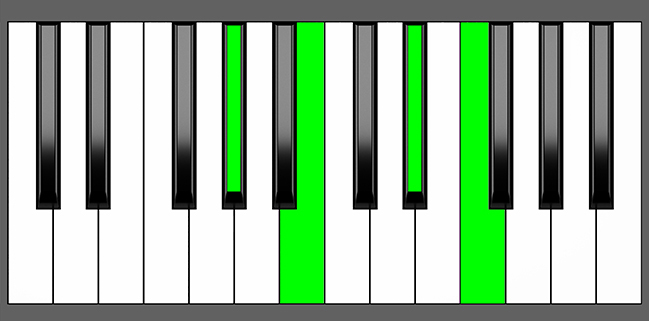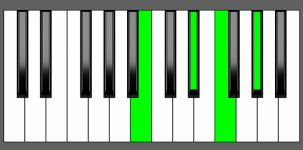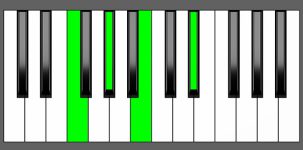Piano Diagram of Abm6 in Root Position

The Abm6 is a chord made up of four notes Ab, Cb, Eb, and F. It’s the minor chord built on the key of Ab with an added major 6th interval (F). It belongs to the chord family of “added tone chords” (aka “add chord”) because it has an extra tone added to a minor triad. In this article, we’ll take a closer look at the music theory behind this chord.
Structure of Abm6
Notes |
|---|
| Ab, Cb, Eb, F |
Intervals |
|---|
| R, m3, 5, 6 |
Finger Position
Left Hand |
|---|
| 5, 3, 2, 1
5, 4, 2, 1 |
Right Hand |
|---|
| 1, 2, 4, 5
1, 2, 3, 4 |
Abm6 Chord Inversions
The Abm6 chord has a total of 3 inversions:
| Root Position: | Ab | Cb | Eb | F |
| 1st Inversion: | Cb | Eb | F | Ab |
| 2nd Inversion: | Eb | F | Ab | Cb |
| 3rd Inversion: | F | Ab | Cb | Eb |
Piano Keyboard Diagrams
Abm6 Chord Equivalencies
Rearranging the notes of a chord can lead to interesting and unique chord equivalencies. This is especially true for 6th chords, as we can create a different type of chord by rearranging the notes of a minor 6th chord in a specific way.
If we take the 3rd inversion of a minor 6th chord, where the 6th note becomes the root note, we end up with a minor 7th flat 5th chord (also known as a half-diminished chord).
For example, let’s take the Abm6 chord, which consists of the notes Ab, Cb, Eb, and F. By rearranging the notes so that F becomes the root note, we get an Fm7b5 chord with the notes F, Ab, Cb, and Eb.
3rd Inversion of Abm6 = Fm7b5
The reason why the 3rd inversion of a minor 6th chord results in a minor 7th flat 5th chord is due to the note relationships between the chords. When we move the 6th note to become the root note, we end up with a chord that has a minor 3rd, diminished 5th, and a minor 7th interval. These intervals are the same as a m7b5 chord.
Also, note that the 3rd inversion of a minor 6th chord is a dominant 9th chord without root. Abm6 3rd inversion is F, Ab, Cb, Eb which could be considered also a Db9 (Db, F, Ab, Cb, Eb) without the root.
Music Theory and Harmony of Abm6
An Ab minor 6th chord consists of four notes, an Ab minor triad, plus a 6th interval. Due to the inclusion of the major sixth interval, represented by the note F, the Ab minor 6th chord generates a sense of tension that can either be resolved by transitioning to a more stable chord or utilized to create a feeling of “uncertain stability.”
Building the Abm6 Chord: Different Approaches
Starting from the Ab Major Scale
To build a minor 6th chord, you would include the root note, minor third, fifth, and sixth from a minor scale. However, when teaching this concept, it can be more effective to demonstrate its construction using a major scale. This is because a major scale better illustrates the relationship between intervals and their respective qualities.
For instance, to build the Abm6 chord, you can start with the Ab Major scale:


To create an Abm6 chord, apply the formula R, m3, 5, 6 in the following manner:
- Begin with the Root note, Ab.
- Select the 3rd interval C then lower it down by a half-tone to get the minor 3rd, Cb (equivalent to a natural B).
- Include the 5th note, which is Eb, to the chord.
- Finally, add the 6th interval, F.
By following this simple formula, you can create a minor 6th chord from any major scale.
by Combining Intervals
One method to create a minor 6th chord is by combining specific intervals – a minor 3rd, a major 3rd, and a major 2nd (a whole-tone).
m3 + 3 + 2 = minor 6th Chords
To illustrate, let’s use the Abm6 chord as an example: by examining the intervals between the notes, we can see that
- Ab-Cb is a minor 3rd interval,
- Cb-Eb is a major 3rd interval,
- and Eb-F is a whole-tone interval.
These three intervals can be stacked together to create the Abm6 chord.
How to Use Abm6 in a Chord Progression
A minor 6th chords can be used as a variation of a minor chords. However, it’s important to understand that the major 6th interval present in this chord may not always be a part of the scale being used.
on Natural minor Scales
| Minor Scales | i | ii | III | iv | v | VI | VII |
|---|---|---|---|---|---|---|---|
| Ab | Ab min7 ⇒ Abm6 | Bbm7b5 | Cb Maj7 | Db min7 | Eb min7 | Fb Maj7 | Gb7 |
| Eb | Eb min7 | Fm7b5 | Gb Maj7 | Ab min7 ⇒ Abm6 | Bb min7 | Cb Maj7 | Db7 |
| Db = C# | C# min7 | D#m7b5 | E Maj7 | F# min7 | G# min7 ⇒ G#m6 = Abm6 | A Maj7 | B7 |
- Non-diatonic Tonic chord in Ab minor
- Subdominant chord in Eb minor
- Non-diatonic Dominant chord in C# minor as G#m6
on Major Scales
| Major Scales | I | ii | iii | IV | V | vi | vii |
|---|---|---|---|---|---|---|---|
| Gb | Gb Maj7 | Ab min7 ⇒ Abm6 | Bb min7 | Cb Maj7 | Db7 | Eb min7 | Fm7b5 |
| Fb = E | E Maj7 | F# min7 | G# min7 ⇒ G#m6 = Abm6 | A Maj7 | B7 | C# min7 | D#m7b5 |
| Cb = B | B Maj7 | C# min7 | D# min7 | E Maj7 | F#7 | G# min7 ⇒ G#m6 = Abm6 | A#m7b5 |
- Supertonic chord in Gb Major
- Non-diatonic Mediant chord in E Major as G#m6
- Non-diatonic Submediant chord in B Major as G#m6
Non-diatonic positions
In the case of the Ab minor 6th chord, the F does not exist in either the Ab natural minor scale or the B major scale. This is why the Ab minor 6th chord (and any other chords with non-scale tones) are called “non-diatonic.”
As a result, it is possible that the inclusion of this chord could cause dissonance within a melody or harmonic progression. So, just be careful when you use this chord in your music. Make sure it works well with the other chords and notes so that it makes the whole piece sound better.
Abm6 in Ab minor (Non-Diatonic)
The Ab minor 6th chord is a unique and intriguing option as the tonic chord in the Ab natural minor scale, as it creates a complex and ambiguous harmonic center. The presence of the major 6th interval (F) adds tension and dissonance to the chord, creating a sense of instability and uncertainty.
However, since F is not included in the scale, the Abm6 may clash with the melody, bass line, or other elements of the music. This dissonance can be used to create a sense of tension, but it can also make the chord difficult to use in certain musical contexts.
Non-diatonic chords, as the Abm6 in this case, can be used to modulate between keys or to add harmonic color and contrast to a composition. It can be used as part of a chromatic modulation to move to a related key or to create a sense of chromaticism within the natural minor scale.
| i | ii | III | iv | v | VI | VII |
| Ab min7 ⇒ Abm6 | Bbm7b5 | Cb Maj7 | Db min7 | Eb min7 | Fb Maj7 | Gb7 |
Abm6 Chord Progressions as i degree
The following chord progressions are examples of how the Ab minor 6th chord can serve as the tonic chord (i degree). I’ve added a possible voicing but it’s just a suggestion.
i VI VII III
| i | VI | VII | III |
| Abm6
(Ab, Cb, Eb, F) |
Fb Maj7
(Ab, Cb, Eb, E) |
Gb7
(Gb, Bb, Db, E) |
Cb Maj7
(Gb, Bb, Cb, Eb) |
Chromatic modulation
| i | iΔ | i7 | i6 |
| Ab min
(Ab, Cb, Eb, Ab) |
Ab min(Maj7)
(Ab, Cb, Eb, G) |
Ab min7
(Ab, Cb, Eb, Gb) |
Ab min6
(Ab, Cb, Eb, F) |
i iv VI VII
| i | iv | VI | VII |
| Ab min7 | Abm6
Ab (B, Eb, Gb) | Ab (Cb, Eb, F)* |
Db min7
(Ab, Cb, Db, E) |
Fb Maj7
(Fb, Ab, Cb, Eb) |
Gb7
(Fb, Gb, Bb, Db) |
(*Play the root note with your left hand and the notes within the brackets with your right hand.)
Abm6 in Eb minor
The Ab minor 6th can also appear as the subdominant chord in the key of Eb minor.
| i | ii | III | iv | v | VI | VII |
| Eb min7 | Fm7b5 | Gb Maj7 | Ab min7 ⇒ Abm6 | Bb min7 | Cb Maj7 | Db7 |
Abm6 Chord Progressions as iv degree
The following chord progressions feature an Abm6 chord as the subdominant (iv degree):
iv III VI VII
| iv | III | VI | VII |
| Abm9 | Abm6
Ab (Cb, Eb, Gb, Bb) | Ab (Cb, Eb, F, Ab) |
Gb Maj7 | Cb Maj7 | Db7 |
i iv VI v
| i | iv | VI | v |
| Eb min7 | Abm6 | Abm7 | Cb Maj7 | Bb min7 |
Abm6 in Db minor (Non-Diatonic)
Abm6 in Gb Major
Besides its use in natural minor scales, the Abm6 chord can also be played in major keys. In the key of Gb major, for instance, the Abm6 chord functions as the supertonic chord, located on the second degree of the scale.
A supertonic minor 6th chord in a major key produces a slightly tense and unresolved sound, creating a feeling of anticipation or expectation as it typically leads to the dominant or subdominant chords.
| I | ii | iii | IV | V | vi | vii |
| Gb Maj7 | Ab min7 ⇒ Abm6 | Bb min7 | Cb Maj7 | Db7 | Eb min7 | Fm7b5 |
Abm6 Chord Progressions as ii degree
Try playing the following chord progressions to better understand how the Abm6 chord functions as the supertonic (ii) chord in the key of Gb major.
ii V I
| ii | V | I |
| Ab min6 | Db7 | Gb Maj7 |
I IV ii V iii vi ii V
| I | IV | ii | V | iii | vi | ii | V |
| Gb Maj7 | Cb Maj7 | Abm6 | Abm7 | Db7 | Bb min7 | Eb min7 | Ab min7 | Db7 |
Abm6 in Fb Major (Non-Diatonic)
Check G#m6 in E Major
Abm6 in Cb Major (Non-Diatonic)
Alternative Nomenclature for Abm6
- Ab -6
- Lab -6
- Lab m6
- Ab m6th
- Ab min6
- Lab min6
- Ab m(add6)
- Ab min add 6
- Ab minor 6th
- Ab minor sixth



